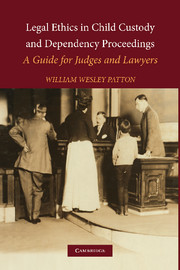Book contents
- Frontmatter
- Contents
- Foreword, by Martin Guggenheim
- Acknowledgments
- Introduction
- 1 Conflicts of Interest
- 2 Competent and Zealous Representation
- 3 Confidentiality
- 4 The Ethics of Alternative Dispute Resolution in Child Custody and Dependency Proceedings
- 5 Ethical Considerations and Constraints in Child Custody and Dependency Appeals
- 6 The Constitutionality of Legislative and Executive Regulation of the Practice of Law and Defining the Attorney-Client Relationship
- Appendix A National Association of Counsel for Children Standards
- Appendix B American Bar Association Standards of Practice for Lawyers Who Represent Children in Abuse and Neglect Cases
- Appendix C In re Car Simulation and Analysis
- Other Authorities
- Cases and Ethics Opinions
- Index
Appendix C - In re Car Simulation and Analysis
Published online by Cambridge University Press: 24 July 2009
- Frontmatter
- Contents
- Foreword, by Martin Guggenheim
- Acknowledgments
- Introduction
- 1 Conflicts of Interest
- 2 Competent and Zealous Representation
- 3 Confidentiality
- 4 The Ethics of Alternative Dispute Resolution in Child Custody and Dependency Proceedings
- 5 Ethical Considerations and Constraints in Child Custody and Dependency Appeals
- 6 The Constitutionality of Legislative and Executive Regulation of the Practice of Law and Defining the Attorney-Client Relationship
- Appendix A National Association of Counsel for Children Standards
- Appendix B American Bar Association Standards of Practice for Lawyers Who Represent Children in Abuse and Neglect Cases
- Appendix C In re Car Simulation and Analysis
- Other Authorities
- Cases and Ethics Opinions
- Index
Summary
IN RE CAR
This case involves four family members, Gail Car (mother), William Car (father), Tifini Car (sister), and Ming Car (sister), in a child abuse dependency action alleging that Gail threw hot water on Tifini, causing her severe burns. The petition also alleges that Tifini is an uncontrollable child who needs to be placed in a court-supervised grouphomewhere shewill learn the importance of being responsible and of following the reasonable demands of her adult custodian. Attached to this set of General Instructions youwill find a 12-page dependency court file that contains all pleadings in the instant case.
Your responsibility in this negotiation and/or mediation is to represent your client(s) during a preadjudication (pretrial) negotiation. You should seek to perfect your client's interests while attempting to resolve this dispute without the necessity of a formal trial (the adjudication hearing). It should be noted that the Department's responsibility is to represent the best interests of the children as determined by the Department. Because the Department's views regarding the children's best interests may conflict with the children's expressed desires, the Code of Professional Responsibility may require the appointment of separate counsel for the children. Assume that you represent both children, Tifini and Ming Car.
The dependency petition alleges that Tifini Car sustained second-degree burns to her body that would not have occurred except for the unreasonable neglectful or intentional acts by her mother, Gail Car. The following petition supplies all the relevant facts.
- Type
- Chapter
- Information
- Legal Ethics in Child Custody and Dependency ProceedingsA Guide for Judges and Lawyers, pp. 223 - 238Publisher: Cambridge University PressPrint publication year: 2006

